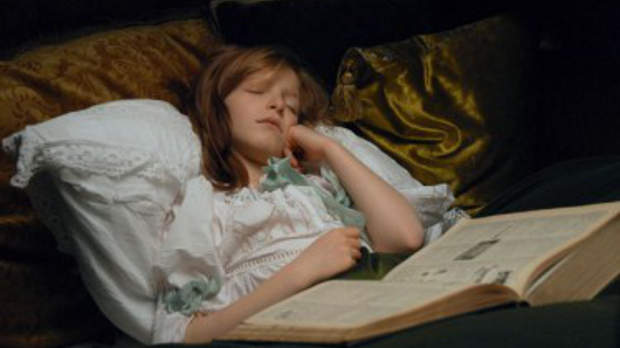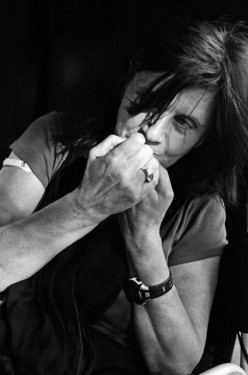 Back to selection
Back to selection
Director Catherine Breillat on Sleeping Beauty

For many adults, The Sleeping Beauty, whether in Charles Perrault’s original telling or the Brothers Grimm’s, is the quintessential fairy tale. It has spawned countless retellings in the form of animated films, ballets, and children’s book adaptations. Now, iconoclastic director Catherine Breillat tackles the tale but on her own terms. For Breillat, The Sleeping Beauty is a doorway into the world of childhood fantasy in general as her young princess, cursed to die on her 16th birthday, travels through time and space, going on a series of adventures that underscore the fearlessness of a child’s imagination — and the adult perils that lie ahead.
The Sleeping Beauty opens today, July 8, from Strand Releasing.

Filmmaker: The Sleeping Beauty is something of a journey film, jumping from place to place, time period to time period. As a screenwriter, what were your initial ideas for this interpretation?
Breillat: The film is a fairy tale of The Sleeping Beauty, which is a pretext to develop another film inside. It’s the dream life of a child. And when you are a child, you are not a child [in your mind], you are a person, a person who has an equality with an adult. [The fairy tale of] Sleeping Beauty was a pretext to put in many other fairy tale allusions. When you are a child, and when you read, you project yourself in the. You fight dragons, and you always succeed. I wanted to show a little girl who dreamed that she was fighting all the worst dangers, who, in childhood, dreams that she’s a great warrior. Then when she becomes an adolescent, she knows nothing. All of her experience doesn’t matter. Like all [stories about] teenagers, it’s a transformation. It’s not the same world. But my The Sleeping Beauty is more [inspired by] Hans Christian Anderson’s The Snow Queen than the fairy tale of Perrault. Much more.
Filmmaker: Were these fairy tales ones you remember reading as a child?
Breillat: Yes. When I was young — we never bought books, because we weren’t rich, but I’d go to the library in my little town. I read them all, and afterwards my mother gave us permission to go to the adult library. So it is the foundation of my character and imagination, these fairy tales and legends.
Filmmaker: Are you talking about this specific film, or more generally?
Breillat: For this film, obviously, but I really found myself in fairy tales and legends.
Filmmaker: Have your ideas of depicting childhood and adolescence changed as you have gotten older?
Breillat: I always think about adolescence, but never childhood. In this movie, yes, at the end I speak about adolescence, but only at the end. But this adolescent at the end, she is the “sleeping beauty” of the whole movie. When she is a child, she is very strong, she has the imagination of a warrior, but when she becomes an adolescent, it’s a new world, she knows nothing, and all her experiences of bravery are useless.
Filmmaker: What sort of production budget and schedule were you working with?
Breillat: It was very low.
Filmmaker: Did you have a philosophy about the film’s design aesthetic that would enable you to do it with these funds?
Breillat: I bought all the dresses from the flea market, I made the shoes, I did the makeup, I painted – I did all the embroidery. I am very obsessed with materials and color, and that’s why I can do period movies on a low budget.
Filmmaker: Its this something you do for all your movies?
Breillat: Yes. The red dress in Romance I bought in a flea market 15 years ago. I thought, that is for a movie! And then I waited and waited.
Filmmaker: How many shooting days did you have?
Breillat: 19 days.
Filmmaker: And do you work with a regular group of collaborations?
Breillat: Yes, my first assistant, who I call “my doomed soul.” I shot in HD and changed my operator of light for this movie — Denis Lenoir, who was marvelous. I think I will make the next one, if he wants, with him.
Filmmaker: Did you think about the image differently since you were shooting in HD for the first time?
Breillat: It’s wonderful. I never would have believed it. I was very afraid. You have an engineer, you can lose [footage]… it’s very stressful for a director before. After, it’s a marvelous way to shoot.
Filmmaker: Did you shoot on the RED?
Breillat: Yes, the RED. We made a test with another one, which was softer than the RED. I have the eyes of an entomologist, and the poetry is not in the blur or the softness of images. So that’s why we chose the RED even if everyone prepares the softness of the other camera. I hate softness. I’ve never had a soft image in my movies. Beautiful, but not soft.
Filmmaker: What’s next?
Breillat: I want to make a trilogy of fairy tales, so the next one I hope will be Beauty and the Beast. I want to do this next project, Abuse of Witness, which is a beautiful title but also a legal term in French about mental harassment.
Filmmaker: Is this a fiction, or based on a true story?
Breillat: All fictions are reality.
Filmmaker: Is it harder to make your kind of “author cinema” in France these days?
Breillat: It is more and more difficult. Now, all the financing from TV is going towards family programs that can show at 8:00 PM, during the dinner, with the children. It’s not only that the money goes to kids movies, it’s that they go to movies with nothing in them that could bother anyone.I think Sleeping Beauty can be for a child, if I cut at the first kiss. The kids see the movie before the kiss, and they were in admiration of it. But the kiss makes it not a kid’s movie.
Filmmaker: What about the changes in the ways people are viewing movies? Are you upset that fewer people see them in theaters?
Breillat: Young filmmakers say they only want to make movies in 35mm for [theatrical] screening, not for TV, but that is completely stupid. All the younger [audience members] see movies on their phones. The problem is to make movie and get the movie to the maximum people possible in the way they want to see it.
